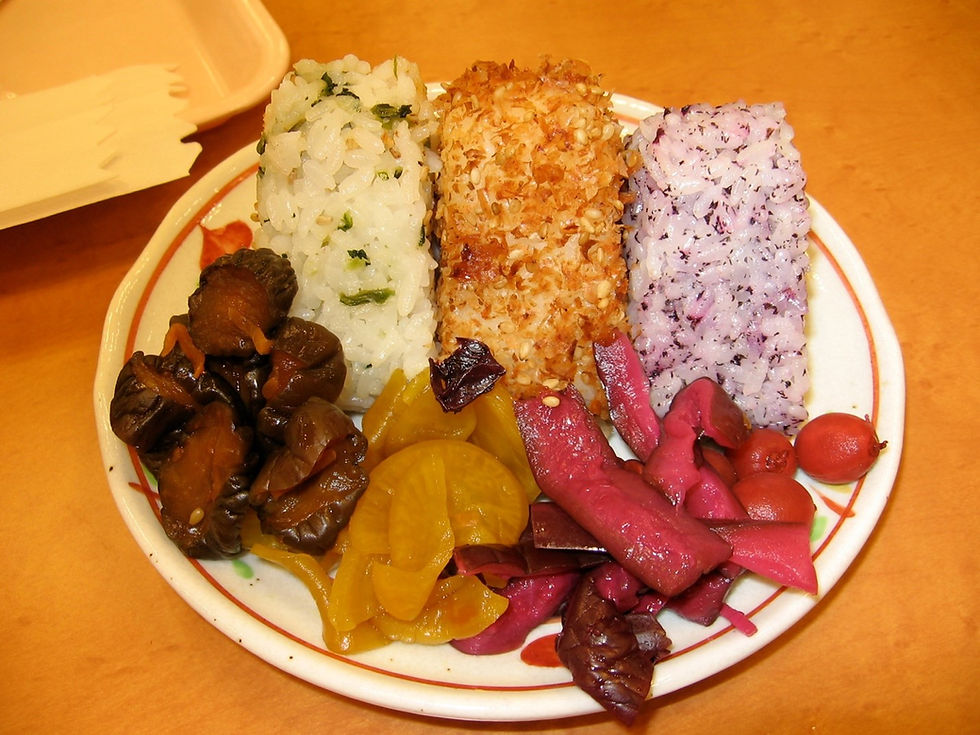1. Obanzai:

Obanzai is a traditional style of home cooking that originates from Kyoto, Japan. The term "obanzai" refers to a type of regional cuisine and the practice of preparing and enjoying local, seasonal dishes in a simple and sustainable way. Obanzai dishes are typically made from a variety of locally sourced and seasonal ingredients.
Obanzai cuisine emphasizes balance, both in terms of flavors and ingredients. The dishes are often prepared with an eye toward minimizing waste, using all parts of the ingredients, and celebrating the natural flavors of each component. Common ingredients in obanzai include vegetables, tofu, fish, and other proteins, prepared in various ways such as simmering, braising, or stir-frying.
The focus of obanzai is on creating a harmonious meal that reflects the season and local offerings. Obanzai can be enjoyed in Kyoto at traditional teahouses or specialized restaurants that showcase the region's culinary heritage. This style of cooking is deeply rooted in Japanese culture and represents a commitment to sustainability, balance, and the celebration of local ingredients.
2. Yudofu:

Yudofu is a traditional Japanese dish that features tofu as the main ingredient. This dish is celebrated for its simplicity and purity, emphasizing the clean and delicate flavors of tofu. Yudofu is particularly popular during the winter months when a warm, comforting meal is appreciated.
To prepare Yudofu, soft or silken tofu is gently simmered in a savory, kombu (seaweed) and soy-based broth. The goal is to warm the tofu without disturbing its delicate texture. This slow simmer allows the tofu to absorb the subtle flavors of the broth, resulting in a soothing and umami-rich dish.
Yudofu is traditionally served in a communal pot at the table, and diners can customize their servings with condiments like grated ginger, sliced green onions, or soy sauce. The warm and subtle flavors of the tofu, along with the umami-rich broth, provide a comforting and soul-warming experience. Yudofu is a testament to the Japanese culinary tradition of celebrating the purity of ingredients and the art of simplicity in cooking. Yudofu offers a unique way to savor the elegance and subtleties of tofu and is beloved by those who value the tranquility and culinary refinement of Japanese cuisine.
3. Kyo Kaiseki:

A variation of kaiseki, Kyo Kaiseki emphasizes Kyoto's local ingredients and flavors, often featuring delicacies like Kyoto-style pickles (tsukemono). Kyo Kaiseki, often referred to simply as Kaiseki, is a traditional and highly refined multi-course dining experience that is deeply rooted in Japanese culinary culture, particularly associated with Kyoto. This meticulously prepared and artful meal is considered the pinnacle of Japanese cuisine, offering an exquisite and immersive culinary journey.
Each course is thoughtfully designed to balance taste, texture, and appearance, offering a harmonious and seasonal experience.
The dishes in a Kyo Kaiseki meal are often influenced by the changing seasons, and the chef uses fresh, locally sourced ingredients to reflect the time of year. These ingredients may include seafood, vegetables, tofu, and more, prepared using a variety of cooking techniques, such as grilling, simmering, or pickling.
Kyo Kaiseki dining often takes place in traditional tea houses or dedicated restaurants in Kyoto, and the presentation is as important as the taste. The meal is typically served as a progression of small courses, which may include appetizers, sashimi, simmered dishes, grilled items, and a beautifully presented dessert.
4. Matcha:

Matcha has a vibrant green color and a distinctive, earthy, and umami-rich flavor. The preparation of matcha involves whisking the powdered tea with hot water to create a frothy and velvety beverage. This process is an integral part of traditional Japanese tea ceremonies, where matcha is served with utmost precision and ritual.
Beyond its traditional use, matcha is also a versatile ingredient that can be incorporated into a variety of culinary creations. It is used in desserts like matcha ice cream, matcha lattes, and matcha-flavored baked goods. Matcha is appreciated not only for its flavor but also for its potential health benefits, as it is rich in antioxidants, vitamins, and minerals. Matcha has become a global phenomenon and is enjoyed by tea enthusiasts and food lovers for its unique taste, vibrant color, and potential health advantages. It is a symbol of Japan's rich tea culture and craftsmanship, and its versatility in both beverages and cooking applications makes it a cherished ingredient in modern cuisine.
5. Kaiseki Ryori:

Kaiseki Ryori, often simply referred to as Kaiseki, is a traditional and highly sophisticated multi-course dining experience that is deeply rooted in Japanese culinary culture. It is a revered form of cuisine, characterized by meticulous preparation, seasonality, and an artful presentation. Kaiseki is a true reflection of Japanese aesthetics and a showcase of the chef's skills.
A Kaiseki meal typically consists of multiple small dishes, each carefully designed to highlight the season's best ingredients and create a culinary journey. The courses may include a mix of appetizers, sashimi, simmered dishes, grilled items, and a beautifully presented dessert.
Kaiseki places great emphasis on the balance of flavors, textures, and colors, aiming to create a harmonious and unforgettable dining experience. The ingredients used are usually locally sourced and represent the changing seasons, ensuring that Kaiseki is always a reflection of nature's beauty and diversity.
Kaiseki is often enjoyed in traditional Japanese ryokan inns, tea houses, or dedicated restaurants. It is not only a meal but an art form, deeply rooted in Japanese culture and celebrated for its attention to detail and the highest level of culinary craftsmanship. Dining on Kaiseki is a cultural experience that offers a glimpse into Japan's culinary heritage and a profound appreciation for aesthetics and gastronomy.

Commentaires